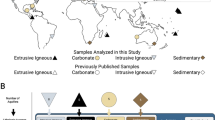Abstract
Dissolved 226Ra (half life 1,600 yr), 228Ra (half life 5.7 yr) and 224Ra (half life 3.64 days) activities in estuarine and coastal waters higher than values reported for open ocean or river waters have been explained by desorption and diffusion of radium from coastal and estuarine sediments1–4. Fluxes of radium isotopes from sediments in Long Island Sound, the Hudson River estuary, Chesapeake Bay and Winyah Bay, South Carolina, have been estimated from mass balances, diffusive bottom fluxes and desorption from suspended sediments4–7. These estimates may not be correct if salt marshes which are intimately associated with estuaries and the coastal ocean are an additional source or sink of radium4. In this study Bly Creek, a small marsh-tidal creek system near Georgetown, South Carolina, was chosen to determine the flux of 228Ra and its great granddaughter, 224Ra, from the sediments to the tidal creek water. We find that the highest activities of 224Ra and 228Ra in the tidal creek waters occur during low tide, but 226Ra activity remains relatively constant throughout the tidal cycle. Fluxes of 224Ra and 228Ra calculated from mass balances required to support the observed activities in the creek waters and measured directly using a flux chamber are consistent. These measurements reveal a large input of radium from the marsh sediments to the overlying waters. To produce the necessary fluxes, irrigation and bioturbation must replace interstitial water in the top 5 cm of the marsh sediments every 2–3 days.
This is a preview of subscription content, access via your institution
Access options
Subscribe to this journal
Receive 51 print issues and online access
$199.00 per year
only $3.90 per issue
Buy this article
- Purchase on Springer Link
- Instant access to full article PDF
Prices may be subject to local taxes which are calculated during checkout
Similar content being viewed by others
References
Moore, W. S. Earth planet. Sci. Lett. 2, 232–234 (1969).
Blanchard, R. L. & Oakes, D. J. geophys. Res. 70, 2911–2921 (1966).
Elsinger, R. J. & Moore, W. S. Earth planet. Sci. Lett. 48, 239–249 (1980).
Elsinger, R. J. & Moore, W. S. Earth planet. Sci. Lett. 64, 430–436 (1983).
Thomson, J., Turekian, K. K. & McCaffrey, R. J. in Estuarine Research Vol. 1 (ed. Cronin, L. E.) 28–44 (Academic, New York, 1975).
Cochran, J. K. thesis Yale Univ. (1979).
Li, Y.-H. & Chan, L. H. Earth planet. Sci. Lett. 43, 343–350 (1978).
Elsinger, R. J., King, P. T. & Moore, W. S. Analyt. chim. Acta 114, 277–281 (1982).
Levy, D. M. thesis Univ. South Carolina (1983).
Moore, W. S. Deep Sea Res. 23, 647–651 (1976).
Li, Y. H. & Gregory, S. Geochim. cosmochim. Acta 38, 703–714 (1974).
Berner, R. A. Early Diagenesis —A Theoretical Approach, 241 (Princeton University Press, 1980).
Cochran, J. K. & Krishnaswami, S. Am. J. Sci. 280, 849–889 (1980).
Author information
Authors and Affiliations
Rights and permissions
About this article
Cite this article
Bollinger, M., Moore, W. Radium fluxes from a salt marsh. Nature 309, 444–446 (1984). https://doi.org/10.1038/309444a0
Received:
Accepted:
Issue Date:
DOI: https://doi.org/10.1038/309444a0
This article is cited by
-
Determining coastal mixing rates of western Taiwan Strait using 224Ra
Journal of Radioanalytical and Nuclear Chemistry (2013)
-
224Ra and its implications in the East China Sea
Journal of Radioanalytical and Nuclear Chemistry (2011)
Comments
By submitting a comment you agree to abide by our Terms and Community Guidelines. If you find something abusive or that does not comply with our terms or guidelines please flag it as inappropriate.



